. a custom rule that uses a match rule
You have the Azure load balancer shown in the Load Balancer exhibit.
LB2 has the backend pools shown in the Backend Pools exhibit.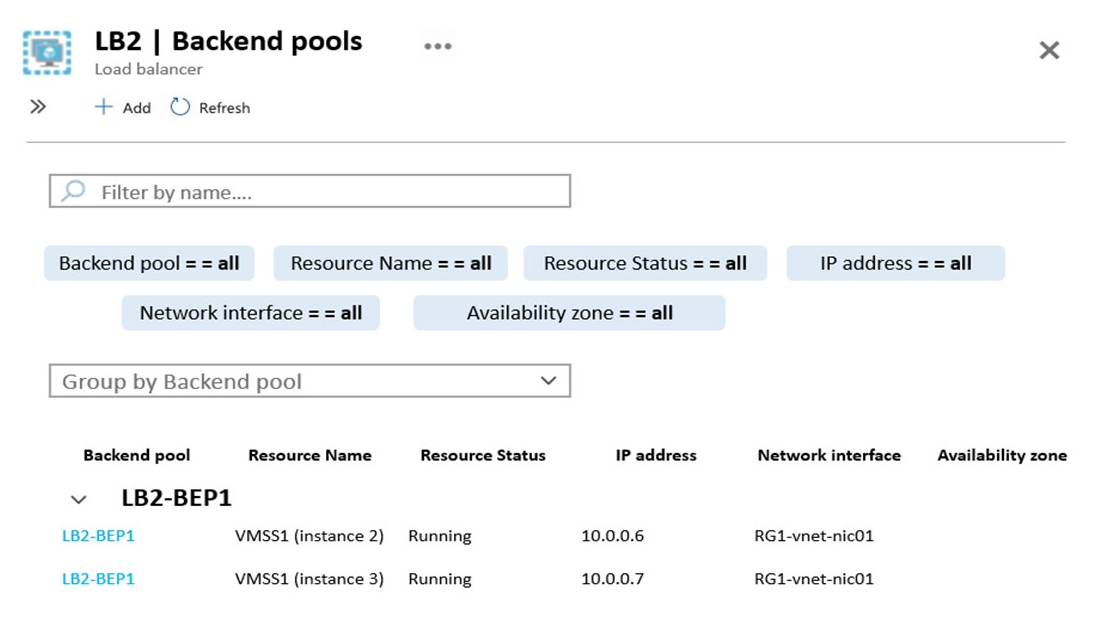
You need to ensure that LB2 distributes traffic to all the members of VMSS1.
Which two actions should you perform? Each correct answer presents part of the solution.
NOTE: Each correct selection is worth one point.
bc
Reference:
https://docs.microsoft.com/en-us/azure/load-balancer/quickstart-load-balancer-standard-public-portal?tabs=option-1-create-load-balancer-standard
HOTSPOT
Case Study
This is a case study. Case studies are not timed separately. You can use as much exam time as you would like to complete each case. However, there may be additional case studies and sections on this exam. You must manage your time to ensure that you are able to complete all questions included on this exam in the time provided.
To answer the questions included in a case study, you will need to reference information that is provided in the case study. Case studies might contain exhibits and other resources that provide more information about the scenario that is described in the case study. Each question is independent of the other questions in this case study.
At the end of this case study, a review screen will appear. This screen allows you to review your answers and to make changes before you move to the next section of the exam. After you begin a new section, you cannot return to this section.
To start the case study
To display the first question in this case study, click the Next button. Use the buttons in the left pane to explore the content of the case study before you answer the questions. Clicking these buttons displays information such as business requirements, existing environment, and problem statements. When you are ready to answer a question, click the Question button to return to the question.
Overview
Contoso, Ltd. is a consulting company that has a main office in San Francisco and a branch office in Dallas.
Contoso recently purchased an Azure subscription and is performing its first pilot project in Azure.
Existing Environment
Azure Network Infrastructure
Contoso has an Azure Active Directory (Azure AD) tenant named contoso.com.
The Azure subscription contains the virtual networks shown in the following table.
Vnet1 contains a virtual network gateway named GW1.
Azure Virtual Machines
The Azure subscription contains virtual machines that run Windows Server 2019 as shown in the following table.
The NSGs are associated to the network interfaces on the virtual machines. Each NSG has one custom security rule that allows RDP connections from the internet. The firewall on each virtual machine allows ICMP traffic.
An application security group named ASG1 is associated to the network interface of VM1.
Azure Network Infrastructure Diagram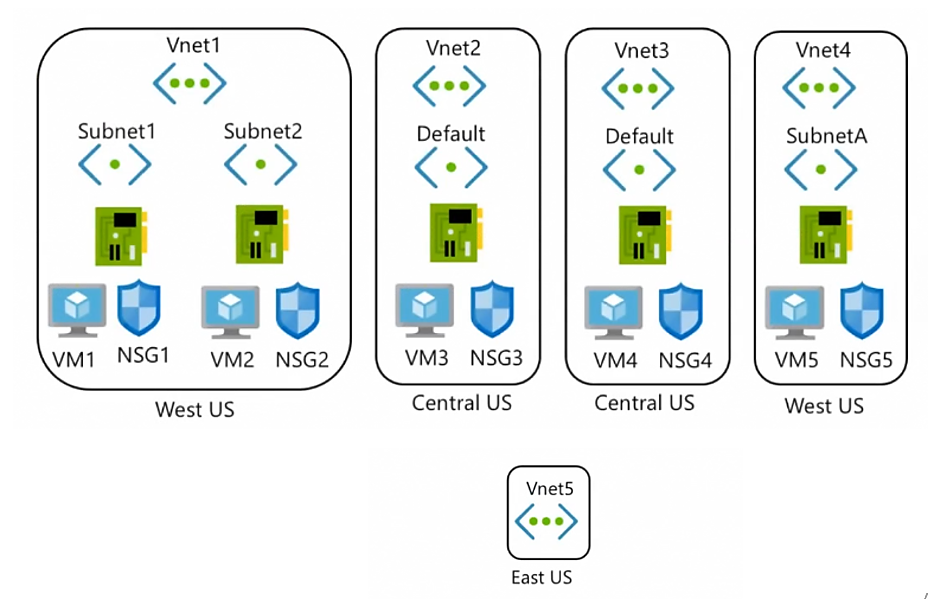
Azure Private DNS Zones
The Azure subscription contains the Azure private DNS zones shown in the following table.
Zone1.contoso.com has the virtual network links shown in the following table.
Other Azure Resources
The Azure subscription contains additional resources as shown in the following table.
Requirements
Virtual Network Requirements
Contoso has the following virtual network requirements:
Create a virtual network named Vnet6 in West US that will contain the following resources and configurations:
o Two container groups that connect to Vnet6
o Three virtual machines that connect to Vnet6
o Allow VPN connections to be established to Vnet6
o Allow the resources in Vnet6 to access KeyVault1, DB1, and Vnet1 over the Microsoft backbone network.
The virtual machines in Vnet4 and Vnet5 must be able to communicate over the Microsoft backbone network.
A virtual machine named VM-Analyze will be deployed to Subnet1. VM-Analyze must inspect the outbound network traffic from Subnet2 to the internet.
Network Security Requirements
Contoso has the following network security requirements:
Configure Azure Active Directory (Azure AD) authentication for Point-to-Site (P2S) VPN users.
Enable NSG flow logs for NSG3 and NSG4.
Create an NSG named NSG10 that will be associated to Vnet1/Subnet1 and will have the custom inbound security rules shown in the following table.
Create an NSG named NSG11 that will be associated to Vnet1/Subnet2 and will have the custom outbound security rules shown in the following table.
You are implementing the virtual network requirements for Vnet6.
What is the minimum number of subnets and service endpoints you should create? To answer, select the appropriate options in the answer area.
NOTE: Each correct selection is worth one point.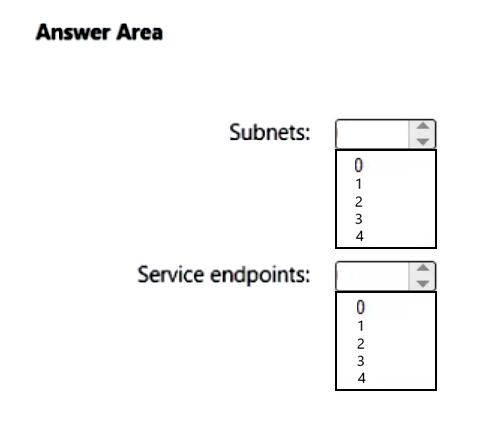
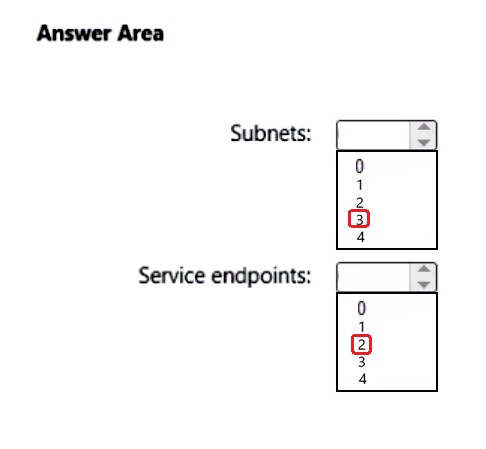
SIMULATION
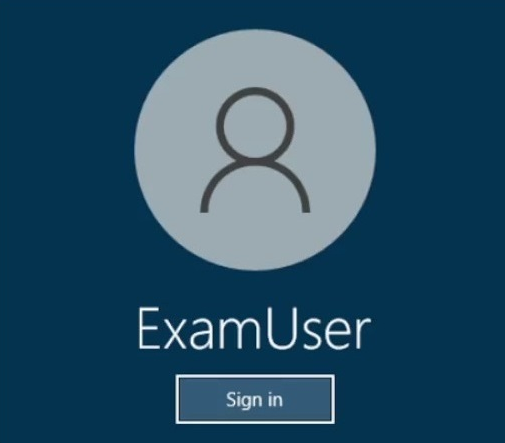
Username and password
Use the following login credentials as needed:
To enter your username, place your cursor in the Sign in box and click on the username below.
To enter your password, place your cursor in the Enter password box and click on the password below.
Azure Username: [email protected]
Azure Password: xxxxxxxxxx
If the Azure portal does not load successfully in the browser, press CTRL-K to reload the
portal in a new browser tab.
The following information is for technical support purposes only:
Lab Instance: 12345678
You need to restrict access to the storage35433841 storage account to ensure that only subnet1-2 can access the account.
To complete this task, sign in to the Azure portal.
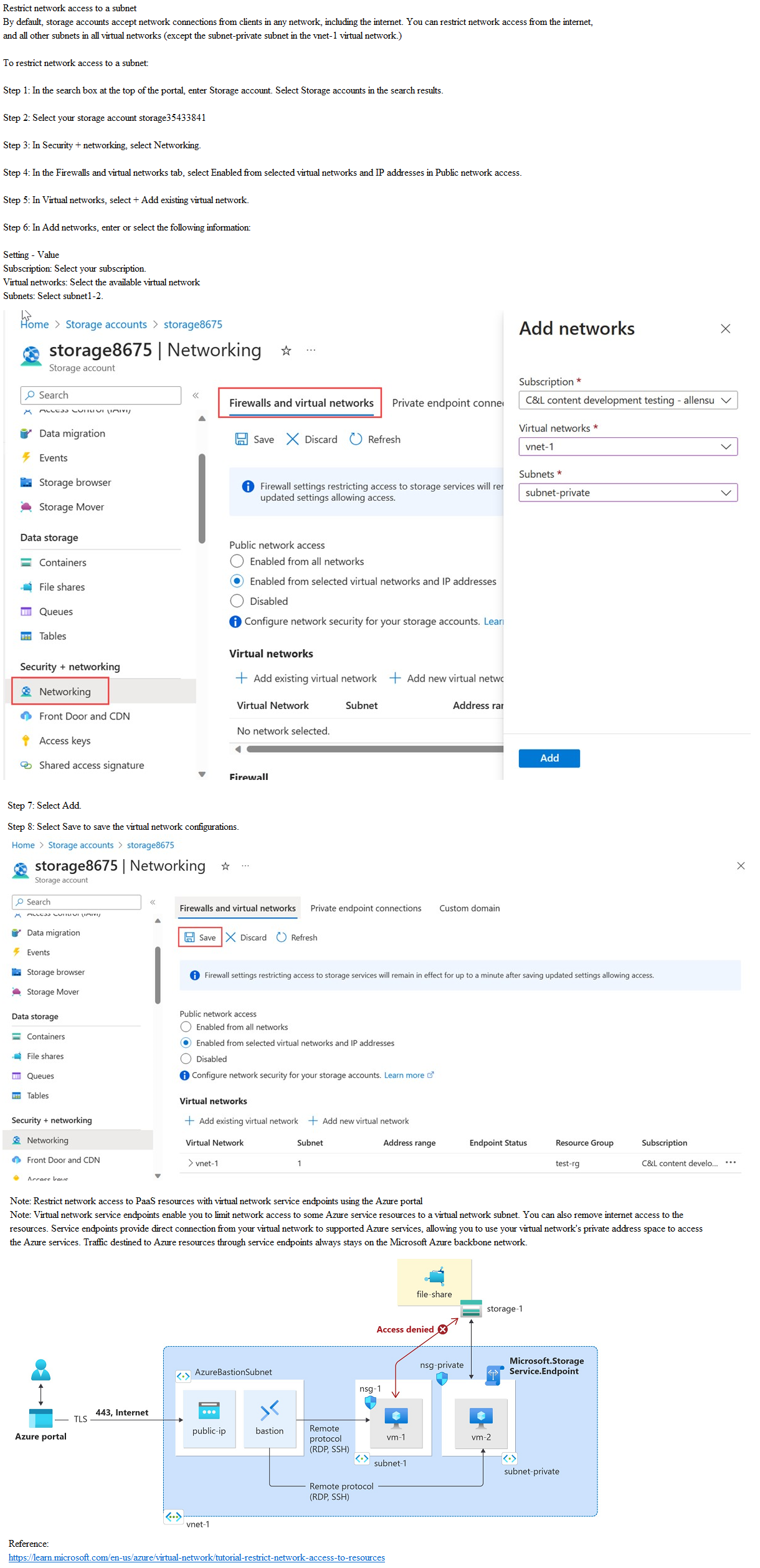
HOTSPOT You have an Azure private DNS zone named contoso.com that is linked to the virtual networks shown in the following table.
The links have auto registration enabled.
You create the virtual machines shown in the following table.
You manually add the following entry to the contoso.com zone:
Name: VM1
IP address: 10.1.10.9
For each of the following statements, select Yes if the statement is true. Otherwise, select No.
NOTE: Each correct selection is worth one point.
Hot Area:

Box 1: No -
The manual DNS record will overwrite the auto-registered DNS record so VM1 will resolve to 10.1.10.9.
Box 2: No -
The DNS record for VM1 is now a manually created record rather than an auto-registered record. Only auto-registered DNS records are deleted when a VM is deleted.
Box 3: No -
This answer depends on how the IP address is changed. To change the IP address of a VM manually, you would need to select 'Static' as the IP address assignment. In this case, the DNS record will not be updated because only DHCP assigned IP addresses are auto-registered.
Reference:
https://docs.microsoft.com/en-us/azure/dns/dns-faq-private
You have an Azure Front Door instance named FD1 that is protected by using Azure Web Application Firewall (WAF).
FD1 uses a frontend hast named app1.contoso.com to provide access to Azure web apps hosted in the East US Azure region and the West US Azure region.
You need to configure FD1 to block requests to app1.contoso.com from all countries other than the United States.
What should you include in the WAF policy?
a
. a custom rule that uses a match rule
HOTSPOT You have an Azure subscription that contains two virtual networks named Vnet1 and Vnet2.
You register a public DNS zone named fabrikam.com. The zone is configured as shown in the Public DNS Zone exhibit.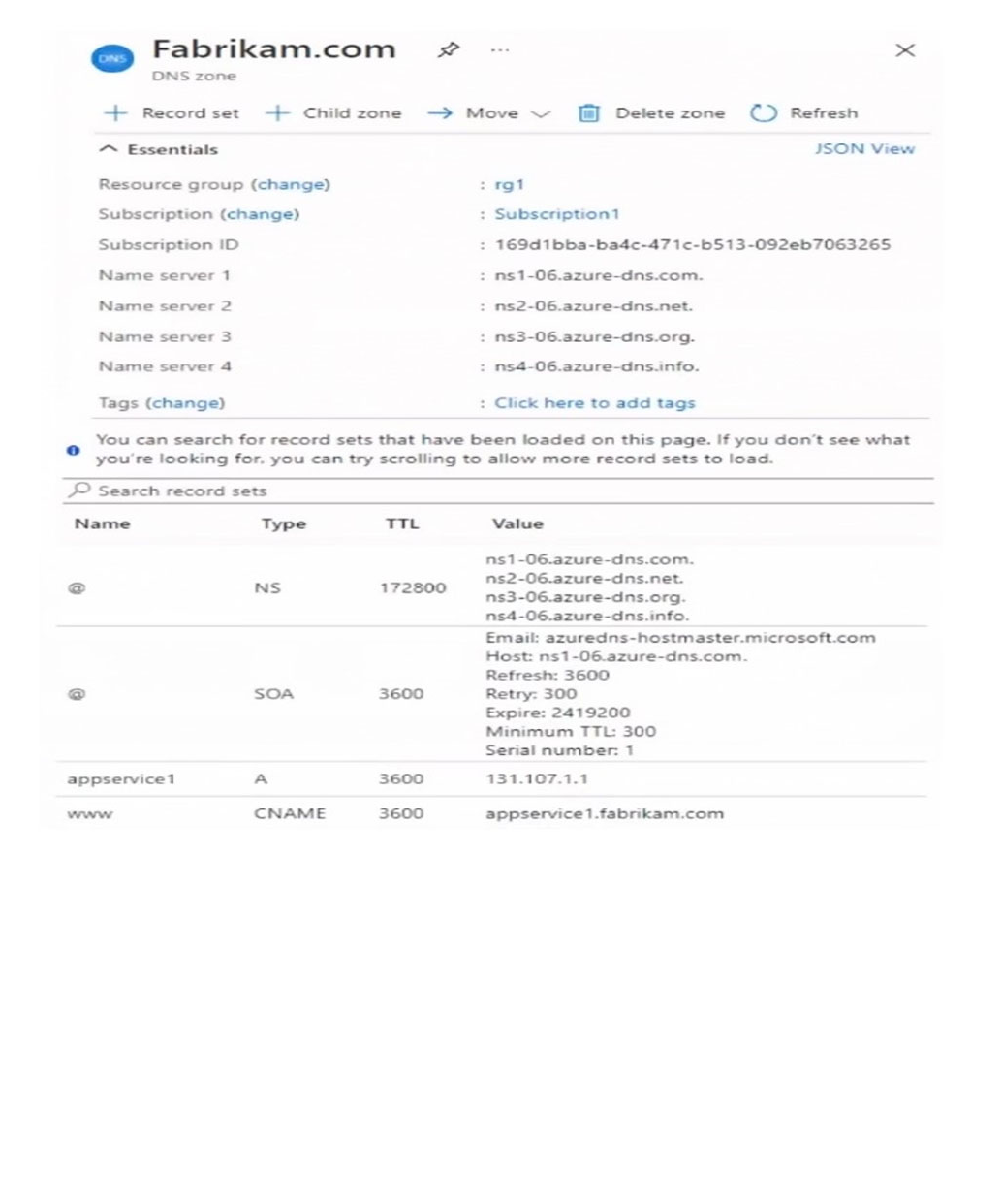
You have a private DNS zone named fabrikam.com. The zone is configured as shown in the Private DNS Zone exhibit.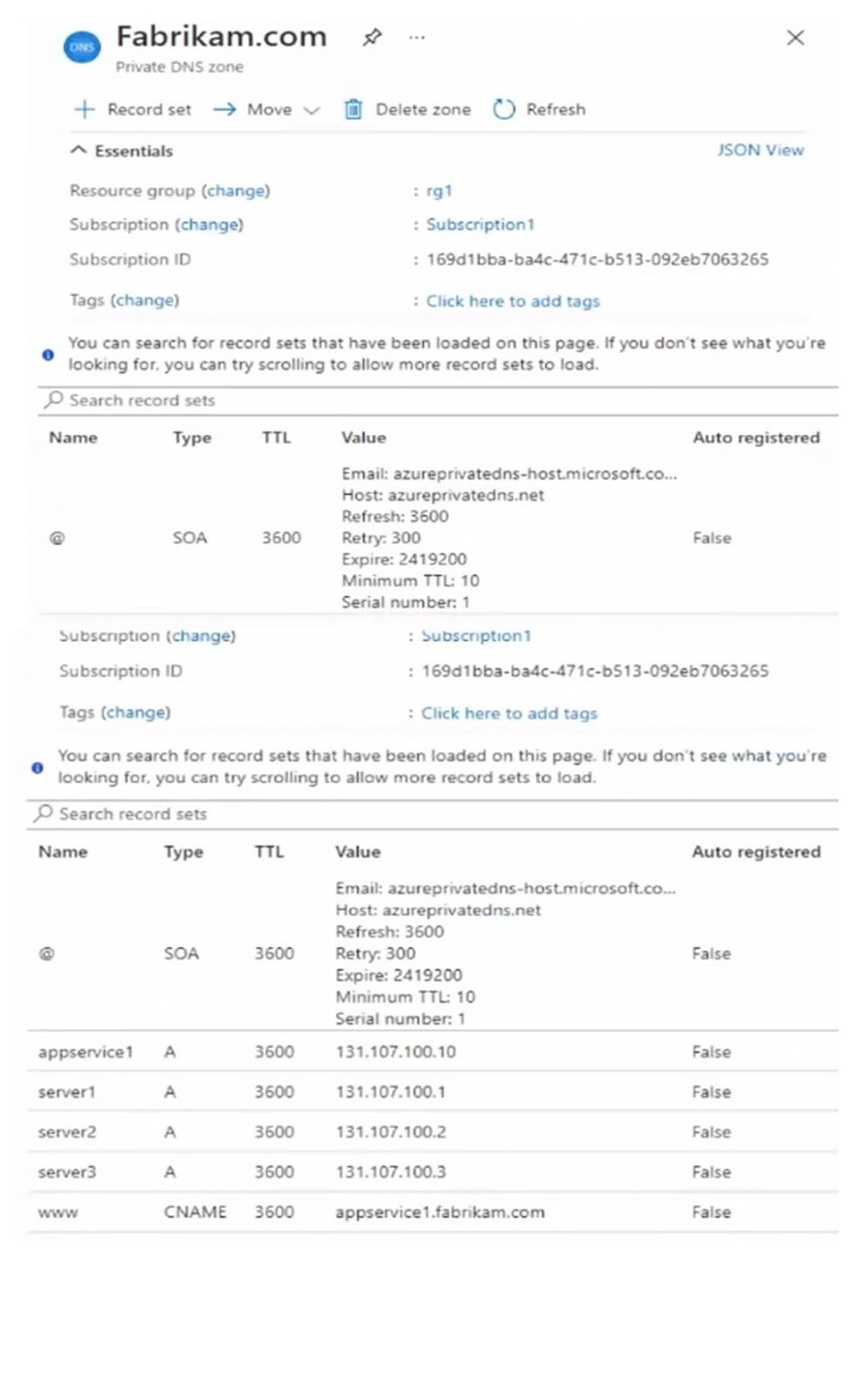
You have a virtual network link configured as shown in the Virtual Network Link exhibit.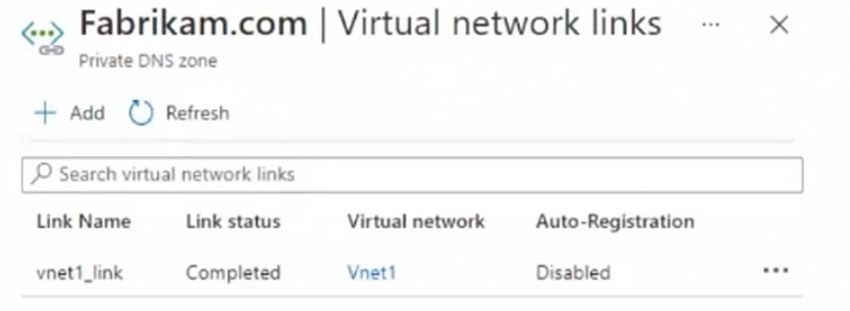
For each of the following statements, select Yes if the statement is true. Otherwise, select No.
NOTE: Each correct selection is worth one point.
Hot Area: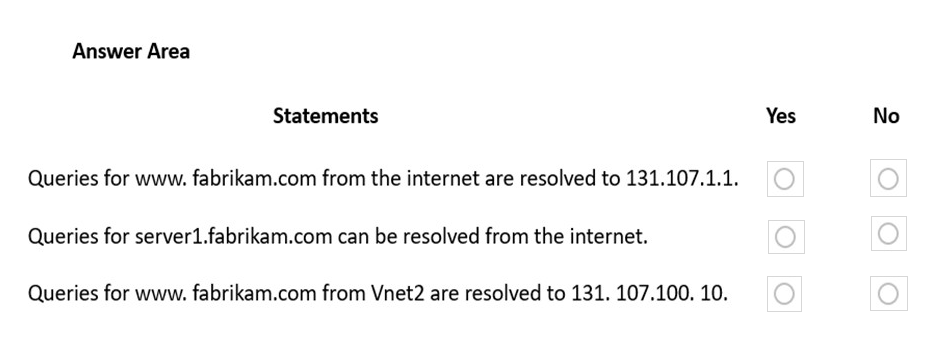
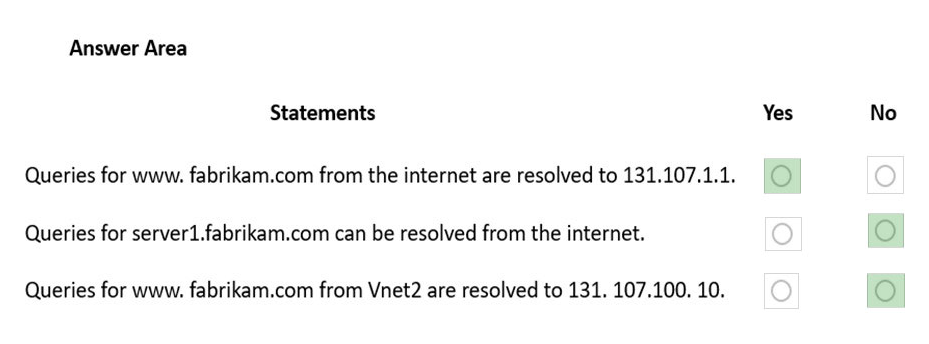
Box 1: Yes -
DNS queries from the internet use the public DNS zone. In the public DNS zone, www.fabrikam.com is a CNAME record that resolves to appservice1.fabrikam.com which resolves to 131.107.1.1.
Box 2: No -
DNS queries from the internet use the public DNS zone. There is no DNS record for server1.fabrikam.com in the public DNS zone.
Box 3: No -
The private DNS zone is linked to VNet1, not VNet2. Therefore, resources in VNet2 cannot query the private DNS zone.
HOTSPOT
You have an Azure subscription that contains an Azure Firewall policy named FWPolicy1.
You need to configure FWPolicy1 to meet the following requirements:
Allow traffic based on the FQDN of the destination.
Allow TCP traffic based on the source.
Which types of rules should you use for each requirement? To answer, select the appropriate options in the answer area.
NOTE: Each correct selection is worth one point.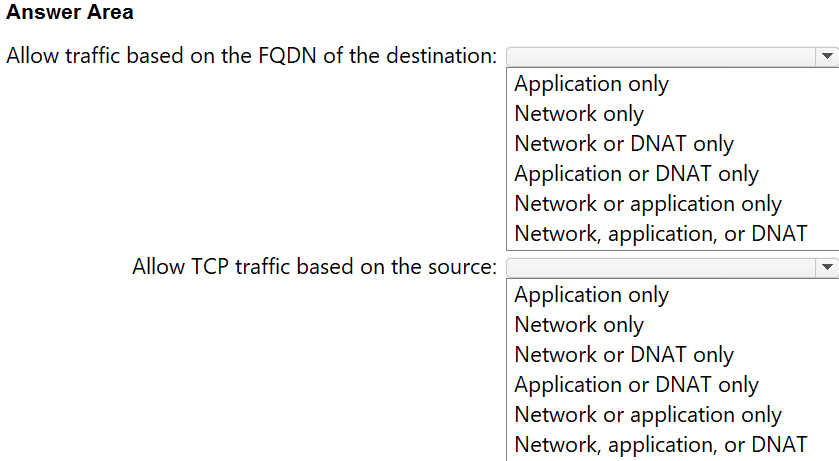
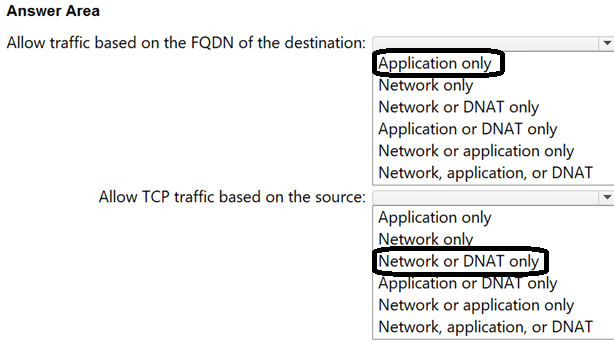
You fail to establish a Site-to-Site VPN connection between your company's main office and an Azure virtual network.
You need to troubleshoot what prevents you from establishing the IPsec tunnel.
Which diagnostic log should you review?
a
Reference:
https://docs.microsoft.com/en-us/azure/vpn-gateway/troubleshoot-vpn-with-azure-diagnostics
HOTSPOT
You have two Azure App Service instances that host the web apps shown the following table.
You deploy an Azure 2 that has one public frontend IP address and two backend pools.
You need to publish all the web apps to the application gateway. Requests must be routed based on the HTTP host headers.
What is the minimum number of listeners and routing rules you should configure? To answer, select the appropriate options in the answer area.
NOTE: Each correct selection is worth one point.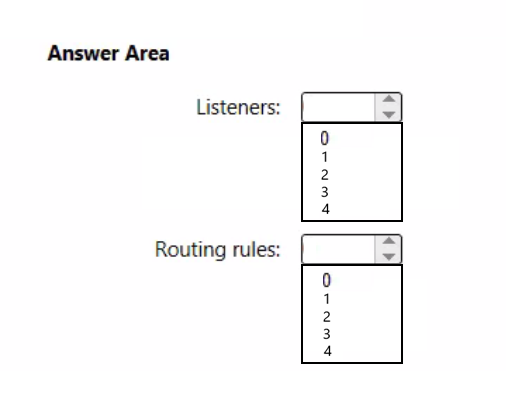
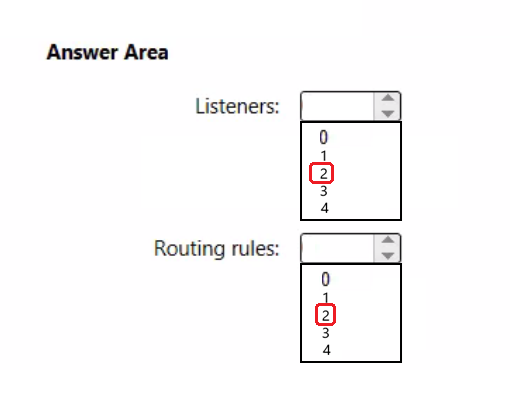
You have an on-premises datacenter and an Azure subscription.
You plan to implement ExpressRoute FastPath.
You need to create an ExpressRoute gateway. The solution must minimize downtime if a single Azure datacenter fails.
Which SKU should you use?
d